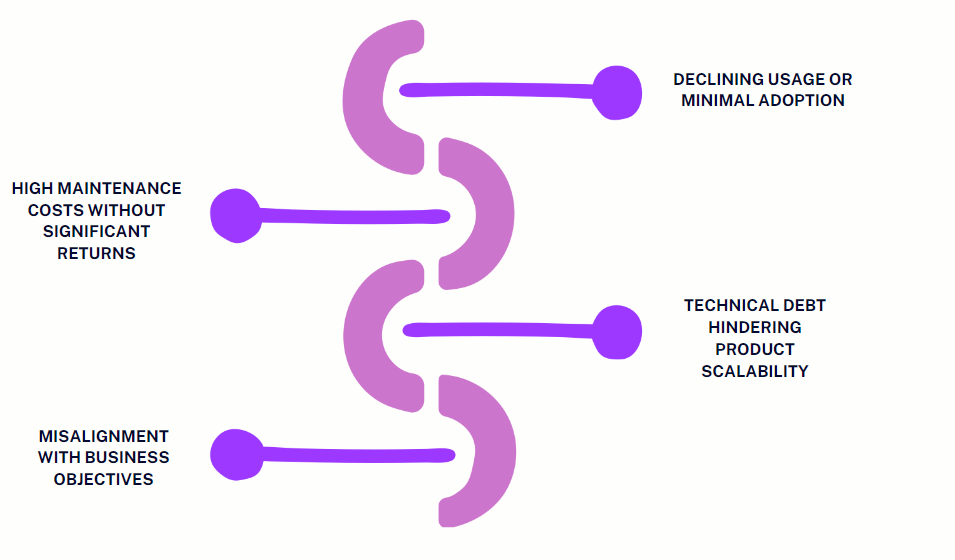Sunsetting a product or decommissioning a specific feature is always a challenging task. Products evolve and so does your target market. When this occurs, some of your product features might become obsolete, underused, or fall out of alignment with business goals.

As a product manager, you play a key role in deciding when and how to sunset a product/feature.
However, to execute a sunset or decommissioning effectively, you need user transition strategies in place to minimize disruption and maintain overall trust. This article covers the key considerations for managing an end of life product/feature and provides you with an easy to follow guide.
When and why to sunset features/products
There are several signs that indicate it may be time to retire a feature. The most common include indicators like declining usage, high maintenance costs, or misalignment with the overall product vision. By retiring a feature, you can reduce technical debt and remove outdated code to free up resources for more impactful initiatives.
Lean on product planning to help you properly assess whether the benefits outweigh the potential drawbacks:

You have to analyze the situation from different perspectives because sunsetting isn’t always the right move. Avoid decommissioning if the feature still plays a critical role for a specific user segment (or fulfills a contractual obligation).
Planning and communicating the decommissioning process
To effectively decommission, make sure that you take the time to plan and build out a strategy that lets you accomplish your ultimate goals. Once you have a clear vision, proactively communicate with your team to prevent confusion and disruption (for end users). Also, make sure to involve internal stakeholders from the outset. This way, everyone understands the rationale and timing.
To review:
- Develop a detailed decommissioning plan. Include timelines, responsibilities, and communication strategies
- Engage internal teams early. Address their concerns and secure support for a smooth transition
- Conduct a risk assessment. Identify potential issues like customer churn, operational impact, and compliance risks
- Create a customer communication plan. Outline key dates, alternatives, and support resources
Throughout the process focus on minimizing risks and maintaining trust with customers (and internal teams). Alongside this, keep an eye on your data management, as this generally presents the biggest challenges for PMs.
How to manage user transition and data migration
Proper data migration is crucial to maintain customer satisfaction. To achieve this, you need a seamless transition plan. Fewer disruptions help retain customer trust, especially when dealing with complex data, and also align with longstanding contractual obligations.
Keep in mind that in most cases decommissioning isn’t a full stop. Why? Your prior agreements might require you to offer support compatibility. Make sure you:
- Communicate clear transition timelines
- Offer step-by-step migration guides
- Provide alternative product options
- Ensure data migration integrity
- Offer limited post-sunset support
- Address contractual obligations early
Remember your end goal should be to maintain a positive customer relationship even as you phase out a product/feature.
Legal and compliance considerations for sunset and decommissioning
You have to execute the entire sunset process without violating regulations or contractual obligations. Carefully assess the legal implications, including data handling, user agreements, and service contracts to avoid costly penalties or damage to your reputation:

The earlier you can address these, the less potential you have for risks. Always safeguard your organization against legal risks.
Measuring the impact of decommissioning and next steps
As a product manager, you must understand the impact of decommissioning (to sunset a product). Analyze feedback from customers and operations, and gather insights on how it affected the overall business objectives. If done right, this should help you refine future strategies and improve the handling of similar processes.
Try to implement these best practices into your workflow:
- Measure customer churn rates
- Analyze support request trends
- Review operational efficiency
- Track cost-saving outcomes
- Gather team feedback
- Identify improvement areas
Performance data gives you valuable insights. These insights help you make better decisions and take action on opportunities for growth. This improves your current operations but also helps the product’s overall lifecycle.
Key takeaways
Remember, feature sunsetting a product and product decommissioning are complex processes that require strategic planning and effective communication. You need a strategy built around minimizing disruptions and maintaining customer trust.
Reference these key takeaways before attempting yourself:
- Identify clear criteria for when to sunset a product or feature
- Develop a structured plan and engage stakeholders early
- The user transition should complement proper data migration
- Address legal and compliance considerations proactively
- Measure the impact and gather insights for future improvements
A focused end of life strategy helps encourage positive product evolution and multifaceted growth. Try implementing these findings within your team and comment with any questions.